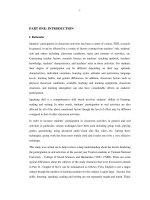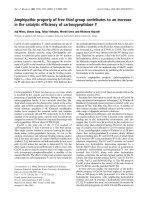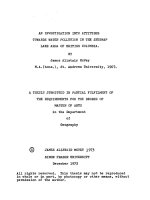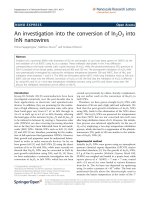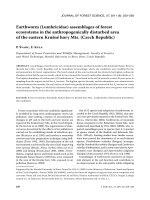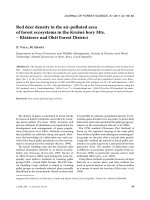AN INVESTIGATION INTO ATTITUDES TOWARDS WARER POLLUTION IN THE SHUSWAP LAKE AREA OF BRITISH COLUMBIA pot
Bạn đang xem bản rút gọn của tài liệu. Xem và tải ngay bản đầy đủ của tài liệu tại đây (2.68 MB, 125 trang )
AN
INVESTIGATION INTO ATTITUDES
TOWARDS WATER PCLLUTION
IN
Tm
SHUSWAP
LAKE
ARJ3A OF BRITISH COLUMBIA.
BY
James
Alistair
McVey
M,A.
(hons.
)
,
st,
Andrews University,
1967.
A
THESIS SUBMITTED
IN
PARTIAL FULFILMENT OF
THE
FU3QUIREmNTS FOR THE DEGFEE OF
MASTER
OF ARTS
in the Department
of
Geography
0
JAMES
ALISTAIR MCVEY
1973
SIMON
FRASER UNIVERSITY
December
1973
All
rights reserved, This thesis
may
not be reproduced
in whole or in part, by photocopy or other means, without
permission of the author.
APPROVAL
Name
r
Degree
:
Title of Thesis
r
James Alistair McVey
Master of
Arts
An Investigation into Attitudes
Towards Water Pollution in the
Shuswap Lake Area
of
British
Columbia
Examining
C
omrnittee
:
Chairman:
E.J.
Hickin
T.
d'~iordan
Senior Supervisor
M.E.
Eliot Hurst
R.C.
Brown
M.L.
Barker
PARTIAL
COPYRICllT LICENSE
I
hereby grant to Simon Fraser University the right to lend
my thesis or dissertation (the title of which
is
shown below) to users
of the Simon Fraser University Library, and to make partial or single
copies only for such users or in response to
a
request from the library
of any other university, or other educational institution, on
its
own
behalf or for one of
its
users.
I
further agree that permission for
multiple copying of this thesis for scholarly purposes may be granted
by me or the Dean of Graduate Studies.
It
is
understood that copying
or publication of this thesis for financial gain shall not be allowed
without my written permission.
Title of Thesis I~issertation
:
Author
:
(signature)
(name
)
,-
(date)
ABSTRACT
During the summer of
1969
an apparent decline in water
quality in Shuswap Lake
became
a
hotly debated political
issue in the Salmon
Arm
area of British Columbia. The
purpose of this study
was
to investigate public awareness
of the pollution problem. In particular, the goal
was
to
isolate the social factors which influenced the level of
awareness of individuals in the community and to determine
the sensitivity of local decision makers to this awareness.
The following hypotheses were theref ore proposed
a
(1)
that awareness of the problems of water quality
will
depend upon the socio-economic status of the
individual, such that
(a)
awareness of the problems of water quality
will
increase with experience in water-
oriented recreation activities and active
involvement in community affairs, and
(b) that
a
sense of political efficacy in coping
with community problems
will
increase with
experience in water-oriented recreation
activities and active involvement in
community
affairs,
(2)
that there
was
no demonstrable difference in the
awareness of the public of both the Village and the
District of Salmon
Arm
concerning problems of
water quality.
To test these hypotheses, a questionnaire survey was
conducted in the two communities during the period when the
iii
debate
was
at
its
peak and there was widespread local concern
for the future quality of the lake.
The results of the study show that awareness, knowledge
and expressed concern for water quality problems are inter-
related. In turn, these are linked to personal experiences
in the use of water through recreational activities,
involvement in community
affairs,
and
a
sense of political
efficacy in coping with community problems, These bonds are
all connected to socio-economic status, which seems to act
as
a
surrogate for the more important variables of experience,
community activity and political efficacy in influencing
preferences for water quality improvement,
The results also suggest that the information channel(s)
between the electors and their representatives
is
extremely
weak, with local decision makers generally unaware
of
public
opinion about local environmental issues,
but
giving the
impression that their actions are conducted in the best
interests of the communities they represent,
TABLE
OF
CONTENTS
PAGE
CHAPTER
I
The rise of concern over environmental quality
.
.
.
1
Attitudes relating to environmental quality issues
.
8
Environmental quality
as
a
political issue
.
.
.
.
.
14
The Study Area
.
. .
. .
. .
. . . . . . . .
.
. . .
19
The Problem: eutrophication
. .
.
. . .
. . .
.
. .
21
Pollution control policy in British Columbia
. . .
.
27
Municipal financing for environmental projects
.
.
.
29
The sewage treatment and water quality issue in
Salmon
Arm.
.
.
.
. .
.
.
.
. .
.
.
.
.
. . .
.
. .
9
Statement of the problem
. . .
.
.
.
.
. . .
.
. . .
34
CHAPTER
II
SAMPLING
AND
ANALYSIS
37
Limitation of the Survey
.
. . .
.
.
.
.
. .
.
.
.
.
40
CHAPTER
I11
RESULTS
OF
THE
STUDY
General findings
. . .
. .
.
.
.
.
. .
.
. .
.
. .
.
42
Participation in water-oriented recreation
.
. .
. .
44
Socio-economic characteristics of the sample
. .
.
.
45
Socio-economic status and awareness of problems of
water quality
.
.
.
.
.
.
. .
. . . . .
.
.
.
.
.
.
48
The relationship
between awareness of water quality
and
frequency of
contact with water bodies
.
.
.
.
49
The relationship between awareness of water quality
and
community activity
.
.
.
. .
.
.
. .
.
.
.
.
.
.
58
The relationship
between social activity and opinion
of the political efficacy of individual action
. . .
64
PAGE
Analysis of the awareness of the residents of the
Village and the
District of Salmon
Arm
concerning
water quality.
. .
.
.
. .
.
.
.
.
.
.
. .
.
.
.
72
CHAPTER
IV
Socio-economic status and awareness of problems of
water quality.
.
.
.
.
.
.
.
.
.
. .
.
.
.
. . .
.
.
79
Experience withwater bodies
.
.
.
.
. . .
.
.
.
.
.
81
Social interaction in the community
.
. .
. .
.
.
. .
81
Efficacy of individual political action
.
. . . .
.
.
83
Public opinion in the two Salmon
Arm
Communities
.
.
85
Futher research needs
.
.
.
. . . .
.
.
.
. .
.
.
.
91
SELECTED
BIBLIOGRAPHY
.
.
0.
.
93
APPENDIX
. .
. . .
.
. .
.
. .
. .
.
.
.
. .
.
.
. .
.
,101
LIST
OF
TABLES
TABLE
-
PAGE
1.
Location of those interviewed
41
2. Recreation Activities pursued by the residents
.
.
45
3.
Age of the sample
46
4.
Occupation of the sample
46
5.
Education of the sample
47
6.
Income of
the
sample
48
7.
Importance of water pollution
as
a
community problem
related to
the
boating
habits
of the respondents
.
50
8.
Awareness of algae bloom problem on Shuswap Lake
related to the boating habits of
the
respondents
.
51
9.
Awareness of algae bloom problem on Shuswap Lake
related to the fishing habits of
the
respondents
.
52
10,Annual family income related to the boating habits
ofthe respondents.
54
1l.Annual family income related to the fishing
habits
of the respondents
55
12.Algae
as
an
indicator of water pollution related
to the swimming
habits
of the respondents
56
13.Algae
as
an
indicator of water pollution related
to the boating
habits
of the respondents
57
14,Importance of
water
pollution
as
a
community pro-
blem related to attendance
at
public meetings.
58
15,Importance of
water
pollution
as
a
community problem
related to the effectiveness of public meetings
as
an information source
60
16.Belief in
an
algae bloom problem on Shuswap Lake
related to qembership in
an
interest group
61
17.Importance of water pollution
as
a
community
problem related to the effectiveness of friends
as
an
information source.
62
18,Algae
as
an
indicator of water pollution related to
the effectiveness of public meetings
as
an
inform-
ation source.
63
19,Algae
as
an
indidator of water pollution related
to active membership in
an
interest group.
64
vii
TABLE
-
PAGE
20.Importance of industry
as
a
source of water pollu-
tion related to the effectiveness of public meet-
ings
as
an information source.
65
21,Importance of septic tanks
as
a
source of water
pollution related to the effectiveness of public
meetings
as
an
information source.
66
22.Membership in
an
action group related to belief in
the efficacy of such activity
67
23.Attendance
at
public meetings related to belief
in
the efficacy of such activity
67
24.Mernbership of an interest group related to agree-
ment with the statement "To control pollution on
Shuswap would be too expensive to be worthwhile."
68
25.
Membership in an interest group related to the
boating habits of the residents
69
26,Membership in
an
interest group related to the
fishing habits of the residents
69
27.Agreement with the statement "To control pollution
on Shuswap would be too expensive to be worthwhilett
related to the boating habits of the residents
.
70
28.Agreement with the statement I1To control pollution
on Shuswap Lake would be too expensive to be worth-
whilew related to the fishing habits of the
residents
71
29.0pinions concerning the seriousness of water pollu-
ti0ninB.C.
73
30.0pinion concerning Shuswap Lake water quality
.
.
73
31.0pinion concerning future Shuswap Lake water
quality.
73
32,The importance of industry
as
a
source of water
pollution in the Shuswap Lake area
74
33,The importance of septic tanks
as
a
source of water
pollution
in
the Shusmap Lake area.
74
34.Agreement with the
statement ItTo control pollution
on
Shuswap Lake would be too expensive to
be
worth-
whileOtt.
75
35.Mernbership in an interest group
76
viii
TABLE
-
36,Attendance
at
public
meetings.
37.Belief in the efficacy of interest
ship.
group member-
38,Belief in the efficacy
of
attending public
meetings.
39.0pinions concerning the possibility
of
uniting
the sewage treatment facilities of the
Village
and
the Municipality.
PAGE
76
76
76
77
LIST
OF
MAPS
AND
FIGURES
PAGE
1.
Hierarchy of traditional national goals
5
MAPS
-
1.
Location of Study Area
19
a
2. Salmon
Arm
Village
and
District
29
a
CHAPTER
1
THE
RISE
OF
CONCERN OVER ENVIRONFiENTAL
QUALITY
The realization that the activities of an achievement-
oriented society, while creating an eagerly sought-after
affluence, have placed excessive quantitative demands upon
our environment has in recent decades led to
a
concern for
environmental cpality
.'
Outdoor recreation, sport, and travel,
made possible by this increasing affluence, have begun to
make demands of our environment that, frequently conflicting
with those of industry, require clean
air
and water and
unspoilt scenery. Such intangible elements, being by def-
inition less easy to define, have necessitated changes in
traditional methods of resource management.
As
White sugg-
ests,* the scope of resource management has been steadily
widening and must continue to do so in order that
a
greater
proportion of society may share enjoyment of that which
is
beautiful in the natural environment.
From the earliest of times, men of enlightenment have
been aware that some kind of close relationship exists
Jarrett
,
He,
(edJ
,
Environmental Quality in
a
grow in^,
Economy, John Hopkins Press, Baltimore,
1966,
Introduction.
White,
G.F.,
Alternatives in Water Management, National
Academy of Sciences, National Research Council, Washington,
D.C.,
1966, p.
6.
between man and nature and have never ceased to speculate
upon the nature of that relati~nshi~.~
It
was
not until the
Nineteenth Century, however, when men of vision finally rec-
ognized the threat to our environment posed by the tremendous
rate
of development in science and technology, that the con-
servation concept truly developedO4 Inspired by men such
as
Mar~h,~ many became aware of the need to balance the many diff-
erent and conflicting demands upon the environment. In his
now classic work, Marsh warned that further disturbing of the
balance between man and nature would have extremely serious
long-term effects upon human beings themselves.
The fundamental
aims
and ideals of the original con-
servation movement are
still
with us. In
its
present form,
however, traditional North American values and goals have
been evaluated in the light of the signs of environmental
deterioration so obvious in the
1960Ts.
The development of
the science of ecology has focussed,
partly through the act-
ivities of the
mass
media, public attention upon the concept
of the Ecosystem,
a
system that stresses the complex biological
interrelationships upon which
all
forms
of
life, including
See
Glacken,
C.J.,
Traces on the Rhodian Shore,
Los Angeles, University of California Press,
1967.
See Burton,
I.,
&
R.W.
Katas (eds.), Readin
s
in
Resource Management and Conservation, Chicag&ty of
aicago Press, 1965, pp. 155
-
226.
See
G.P.
Marsh, Man and Nature, New York, Scribner*
s,
1864. Also, Glacken,
C.
J.
,
"lhe
origins of the Conservation
Philosophyw, in Journal of Soil and Water Conservation,
Vol.
XI,
No.
2,
'1956.
man himself, depende6
The
views of the ecologists7 have
been widely published and
it
is
perhaps due to their in-
fluence that much of the emphasis of the conservation
movement has, to some extent, "shifted from anthropocentric
thinking to
a
more humble, ecological concept in which man
is
but one organism in a mutually dependent system of
organisms
.
.W
The present generation of conservationists
do not accept that the environment
is
freely available for
all men to use, but that
its
use should be balanced against
other non-economic needs. Such
a
philosophy, finding wide
popularity in an age of widespread intellectual and aesthetic
protest (against the Vietnam war, racism, the corporate elite,
and other readily-accepted values of previous decades) does
not hold that the economic development of the landscape
is
an ideal end in itself. Economic development and growth may
The ecosystem, a term first proposed by Tansley in
1935,
is
defined as comprising the interacting, living and
non-living, elements in
a
particular habitat.
For example see: Bates
M.
,
Man in Nature, Englewood
Cliffs,
N.
J.
Prentice-Hall 1964; The Forest and the
Sea,
New York, Random House, 19b0;
Commoner,
B.,
Science and Survival, New York, Viking
Press, 1966
;
The Closing Circle,
New
York, Knopf, 1971
;
Ehrlich
,
P.
R.
,
and
A
.H.
,
Population, Resources,
Environment, San Francisco, Freeman,
1970
;
Watt,
K.E.F., Ecol and Resource Mana~ement,
New York, McGraw-Hill,
19
Lacey,
M.J.,
"Man,
Nature and the Ecological Perspect
in American Studies, Vol
8,
1970,
pp.
1-3, 13-27.
'
OTRiordan,
T.
,
"The Third American Conservation
Movement
:
New Implications for Public Policy, in Journal
of
American Studies, Vol. 5, No. 2,
1971,
pp.
161-lc
be
a
vital element in the national political decision-
making process, but the "newn conservation philosophy
is
in
direct conflict with the traditional economic interests of
the capitalist system: The aesthetic values of
a
beautiful
lake area may therefore be in conflict with economic interests
who wish to exploit the tourist potential of the same area.
The present conservation movement, therefore, seeks
a
reorientation of the nation's goals and values.
The most
important of these goals have been viewed
as
being both
"incompatible and hierarchical in priorityn
,9
as
Figure
1
demonstrates. The attention given to the goals lower in
the hierarchy depends upon the degree to which the more
important goals are met; the new conservationists, the voices
of whom are
becoming increasingly vocal (aided, to
a
con-
siderable extent, by the attentions of the media) wish to
see environmental quality and ecological harmony in bal-
ance with, rather than supplanted by, economic growth and
equal social opportunity
as
popularly accepted goals. Con-
servation could thus
be
viewed
as
a
socio-political ethic,
10
a
philosophy
of
resource management which seeks to balance
For further details see OvRiordan,
T.,
Ibid.,
p.
163.
See also Rokeach
,
M.
.
"The Role of Values in
P-
Opinion
Researchn, in Public -opinion Quarterly, Vol
.
32,
1968;
pp.
347-359.
lo
See Fleischmann,
P.
,
nConservetion: The Biological
Fallacyn,
in
Landscape, Vol.
18,
No. 2,
1969,
pp. 23-26.
Fleischmann maintains that conservation has no biological
justification, nature being
a
dynamic system ever changing
its
checks, balances, and interrelationships.
It
is
based,
rather, upon
human
value systems.
Figure
1.
HIERARCHY
OF
TRADITIONAL
NATIONAL
GOALS
(after
0'~iordanf
NATIONAL
ECONOIUC
+
GROWTH
INCOl6E
.REDISTRIBUTION
ECOLOGICAL
the preserva
the beautiful
i
n
,
and the harmony of,
nature against the popularly-perceived need for economic
growth and development.
The recent upsurge of public interest in environmental
quality would appear to be partly explained by
a
greater
publtc concern over the signs of environmental deterioration.
Public opinion polls conducted by geographers and other
social scientists have recorded views about environmental
I/
li
issues.
l1
Two maior surveys of American polls have shown
i
For
a
review, see Saarimen,
T.F.,
Environmental
I
Perce tion, Washington,
D.C.,
Association o erican
'I
ds,
Resource Paper No.
5,
1969;
"Refsgrch Approaches
and Questionaire Designn, in Sewell,
W.R.D.
and
I.
Burton
(eds.), Perceptions and Attitudes in &sources Kanaeement
Ottawa,
Information Ganada,
1971,
pp. 13-26.
1
i
that, between 1965 and
1970,
the issue of reducing pollution
rose from ninth out of ten most serious problems facing the
United States to second (behind the state of the economy),
and that the number of those prepared to pay more of their
income to clean up the environment increased by 20%.
12
Such opinion polls, however, register only the expression
of concern;13 they do not necessarily demonstrate the ex-
tent of individual commitment to accept responsibility for
bringing about improved environmental quality.
It
could thus
be said that public opinion surveys do not adequately show
the connection between verbal statements (expressed concern)
and overt behaviour (concern that
is
translated into action).
14
Prior to the expression or demonstration of concern,
blunton,
D.
,
and
i.
Brady, American public opinion
and environmental pollution, Columhs, Ohio, Ohio State
University. 1970;
~bskine
,
-H.
,
"The polls: pollution and
its
costsh,
in Public Opinion Quarterly, Vol. 35,
1971,
pp. 120-35.
l3
Within the context of this study, vconcernv
is
def-
ined
as
an anxious response on behalf of an object
,
idea, or
state of
affairs
that one views
as
being important or signif-
icant. Concern therefore involves judgements and preferences
made by the individual that are affected
by
both the internal
value system of the individual and that of the society of
which he or she
is
a member.
l4
The nature of the connection has been of interest to
social scientists for over
30
years. Ueutscher, however,
notes that many sociologists have ignored the problem, many
scientific conclusions in the social sciences continuing to
be based upon verbal resvonses rather than upon overt be-
haviour.
see
~eutscher
,*
la
,
"Words and Ueeds: Social Science
and social Policyn, in Social Problems, Vol.
13,
No. 2,
1966,
p. 236.
however, one must be aware of an object.
l5
his
cognitive
process leads to belief patterns that
contain within them
understanding of linkages that may exist between the phenomena
of which the individual
is
aware. For concern to be trans-
formed from a verbal expression into action, knowledge of
these linkages
is
necessary. One
is
more likely to desist
from using detergents containing phosphates
if
one under-
stands the linkages between the use of such detergents,
untreated municipal effluent, and increased biological pro-
ductivity in waters receiving the effluent. Heberlein, in
conducting a field experiment concerning littering behaviour,
discovered that those who were aware of the consequences of
-
their actions were less likely to litter,
behaving "according
to moral norms rather than economic expedienceen
l6
It
would
appear, therefore, that an understanding of the level of
-
awareness of the individual
is
important when testing the
degree of concern over environmental quality issues.
l5
nAwarenessw has been defined as
e
state of being
knowledgeable about n something through alertness in
observing or interpreting what one
sees,
hears, feels, etcen,
Websterst New World Dictionary, (College Edition), Toronto,
Nelson, Foster and Scott,
1966.
l6
See Heberlein,
T.A.,
"The Land Ethic Realized: Some
Social Psychological Explanations for Changing Environmental
Attitudesv, in Journal of Social Issues, Vol. 28, No.
4,
1972,
p.
82.
ATTITUDES RELATING
TO
ENVIRaNGENTAL QUALITY
ISSUES
As
Schiff has noted, the increased interest in environ-
mental quality has been accompanied by
a
"flood of papers
focusing on perception of and attitudes toward the environ-
ment. The contributions of scholars working within the
confines of
a
variety of disciplines,
each with
its
own app-
roaches and interests, have led to some confusion in defining
nperceptionn and "attitudett.
l*
In addition, the term
nopinion"
is
frequently
used
interchangeably with "attitudew
when describing an individual's preference towards something.
19
Although the
relationship between ttopinionn and
nattituden
is
indeed an intimate one, some distinctions
between the two
terms
may be made.
An opinion may be defined
as
a
verbally-expressed belief or group of beliefs,
not
based upon positive knowledge but held to be true,
valid,
or probable.
20
An attitude, on the other hand,
is
not nec-
essarily expressed verbally and may be regarded
as
an eval-
uative stance towards, or an organization of beliefs about,
l7
Schiff,
M.R.
,
nThe Definition of Perceptions and
Attitudesn, in Sewell,
W.R.D.,
&
I.
Burton (eds.), op,cit.,
p.
7.
l*
See
0'
Riordan,
T.
,
Perspectives on Resource Management,
London, Pion Ltd.,
1971,
p.
94.
l9
White, C.F.
'Formation and Role of Public Attitudesn,
in Jarrett,
H.
(ed.j, op.cit., p. 110.
20
See Kiesler,
C.A.,
B.E.
Collins,
&
N.
Miller,
Attitude Change:
A
critical analysis of theoretical approaches,
New
York,
John Wiley,
1969,
p. 104.
an object or objects.
21
In other words, an opinion
is
a
loosely-held set of beliefs while an attitude
is
a
coll-
ection of beliefs and feelings which lead to
a
particular
predisposition.
The confusion concerning the definitions of "perceptionn
and "attituden
is
increased by the fact that there may not
appear to be much difference between the two.
As
Schiff
suggests, weemeattitudes affect perception, perception
aff-
ects attitudes, and cognition plays
a
role in both of them."
22
The concept of perception
is
basic to an understanding
of man's interrelationships with his environment. Perception
involves
a
conscious, cognitive interpretation of
a
stimulus
or
a
set of stimuli: Each individual therefore views the
physical and the cultural, the tangible and the intangible,
components of the environment from the vantage-point of his,
or her, own perspective, through
a
wfiltern provided by
culture, socio-psychological background, training, and exper-
ience.
*'
An individualt
s
actions primarily occur not within
the "real',' or phenomenal, environment but rather within the
environment
as
perceived and, therefore, interpreted
by
21
See Hollander,
E.
P.,
Principles and Methods of
Social
Ps
cholo
,
New York, Oxford University Press,
1967,
pp.
2
-5
and
22
Schiff,
M.R.,
Op.cit., p.
8.
23
See Lowenthal
,
D.
,
"Geography, Experience, and
Imagination: Towards
a
Geographical Epistemology* in
Annuals of the Association of American Geographers, Vol.
51,
961, PP
241
-
60.
himO2'
One
is
not dealing with conditions and events ex-
ternal to an individual, but with
n
some kind of psychological interaction bet-
ween the individual's felt needs and stored
knowledge on the one hand, and the signals or mess-
ages coqyeyed to him via his sensory organs, on the
other.
ft
Furthermore,
one has
first
to be aware of an object before
it
can be said that one has perceived the object.
As
a res-
ult, the term "perceptionn
is
more accurately used on those
occasions when an actual stimulus, or set of stimuli,
is
present.
26
An attitude, following the definition above,
is
a
,
learned predisposition that may guide an individual's res-
ponse to
a
certain stimulus or set of stimuli.
Although
there are many definitions of the term,
it
is
generally agreed
by many psychologists that an attitude has an affective and
a
cognitive component.
27
The former
is
an individual's aff-
inity for, or aversion to, the object of the attitude.
28
Such feelings (likes and dislikes, for example) are influenced
24
Sonnenfeld
,
J.
,
"Geography, Perception, and the
Behavioral Environmentn,
a
paper presented
at
the
Dallas
'
A.A.A.S.,
December
1968,
in
a
symposium on "The Use of Space
by Animals and Man."
25
Sprout,
H.
and
M.
,
The Ecological Perspective on
Human Affairs, Princeton,
N.J.,
Princeton University Press,
965,
p.
lor
26
Schiff,
M.R.,
Op.cit., p.8.
27
Schiff,
M.R.,
Loc.cit.
28
Bem,
D.
J.,
Beliefs, Attitudes, and
Human
Affairs,
Belmont
,
California, Brooks/Cole
,
lw,
p.
14.
by perception, social background and past behaviour patterns.
They are also associated with the cognitive component which
consists of the beliefs held by an individual, these latter
being partly dependent upon the awareness level.
These
aff-
ects and
cognition are therefore organized by the individual
into a system that develops the predispostion which enables
him to relate favourably or unfavourably to the object of
the attitude.
The definitive boundaries between opinion and attitude,
and perception and attitude would seem, therefore, to be
most indistinct.
Of
greater importance, perhaps,
is
the
need to better understand the link between the verbal ex-
pression of
concern/opinions/attitudes
and overt behaviour
29
In other words,
in matters concerning environmental quality,
what individuals think
is
not as important as what people
will
do.
30
Environmental attitudes would seem to be better
measured by attendance
at
public meetings, where environmental
issues are discussed, and membership in environmental interest
groups than by the verbal expression of concern over related
problems
.
A
series of studies have
attempted to analyse attitudes
29
See Schiff
,
M.R.
,
"Some considerations about attitude
studies in resource mangementw, Waterloo, Dept. of Geography,
Waterloo-Lutheran University,
1971
(rnimeo); also O'Riordan,
T.,
"Some reflections on environmental attitudes and environmental
behaviourw, in Area, Vol.
5,
No.
1,
1973,
pp.
17-21.
j0
Schiff,
M.R.,
0
.cit
p.
8.
Schiff expresses the
view that,
while
the trad
*'
tlonal "attitudesw study still-has
its
place in studies of environmental quality, environmental
behaviour should be the major object of such studies.
12
towards environmental quality.
Barker placed emphasis upon
measurement of the
social consequences of
a
deterioration in
water quality and examination of the attitudes towards the
use of water recreation facilities.
31
She found that diff-
erences in perception were important in accounting for
variations in user behaviour associated with recreational
opportunities.
Previous experience
was
also an important
factor, perception of pollution increasing with the number
of visits to water.
It
was
also discovered that individuals
and groups would rationalize the local pollution situation
by stating that more serious condtions existed elsewhere.
Frederickson and Magnas, in
a
random sample survey of
the attitudes of residents of Syracuse,
N.Y.,
towards water
pollution
as
a
local problem noted that people regarded
water quality problems differently, on the basis of differing
socio-economic characteristics.
32
They found that people of
lower socio-economic status, who were predominantly black,
poor, and ill-educated and who were likely to live nearer to
the city centre, were not
as
concerned about water pollution
as
a
public problem whereas the more affluent, better-
educated, and usually white, suburbanites felt more directly
31
Barker,
M.L.,
"The Perception of Water Quality
as
a
Factor in Consumer Attitudes and Space Preferences in Out-
door Recreationn, unpublished
M.A.
Thesis, Dept. of
Geography, Unviersity of Toronto,
1968.
32
Frederickson,
H.G.
k
H.
Magnas, nComparing Attitudes
toward Water Pollution in Syracusen
in
Water
Resources
Research, Vol.
4,
1968,
No.
5,
pp.
877-889.
affected by water pollution and placed
it
higher in their
set of policy preferences. 33
In a study of attitudes towards
air
and water pollution
in Victoria,
B.C.,
Lycan and Sewell found that middle class
residents tended to regard pollution
as
being
a
more serious
problem than did residents of lower socio-economic status. 34
In addition, two more recent studies have also suggested
that those individuals of higher socia-economic status
(measured on the basis of income, occupation, and travel ex-
perience)
consider environmental quality issues to
rank high
in
a
list
of problems facing communities
(law
and order,
jobs, housing, education, etc
.
)
.
35
There would appear to
be
a
relationship between socio-
economic status and opinions and attitudes. Some social
psychologists suggest that an individual's opinion and
att-
itude are created and modified by social influences.
36
1n
33
Frederickson,
H.G.,
and
H.
Magnas, Ibid., p.
888.
34
Lycan,
D.R.,
and
W,R.D.
Sewell, "Water and
air
poll-
ution
as
components of the urban environment of Victoria,"
in Geographical Perspectives
,
Vancouver,
B.
C
.
Tantalus
Press,
1968,
pp. 13-18,
35
Tognacci, L.N.,
R.H.
Wergel,
M.F.
Wideen, and
D.A.T.
Vernon, nEnvironrnental Quality: how universal
is
public con-
ern?^,
in Environment and Behaviour, Vol.
4,
1972, pp. 73-86.
Constantini,
E.
and
K.
Hanf. "Environmental concern
and Lake Tahoen
,
in-~nvironment and -~ehaviour, Vol. 4, 1972,
pp. 209-242.
36
Bern
notes that nsocial influences range
from
ex-
plicit attempts of
a
salesman to modify single, isolated
opinion to a societyts ability to inculcate an entire non-
conscious ideology into
its
citizen~.,,.~ See
Bern,
D.Jmf
Op.cit., p.
71,
particular, interpersonal influence
is
of more importance
than mass media in nodifying opinions and attitudes. The
role of opinion leaders and the 111ost active members in the
community
is
thus vital to opinion and attitude formation. 37
Little has been done, however, to test the importance
of these findings with regard to environmental pollution.
With this in mind, one of the objectives of this study
was
to examine to what extent socio-economic status
and
other
related social factors influence the level of public awareness
regarding local water quality problems and, in particular,
the extent to which they affect the optimism that such.po1-
itical action
as
membership in an interest group and attend-
ance
at
public meetings can exert influence in the local pol-
itical
forum towards controlling such problems.
ENVIROIWENTAL
QUALITY
AS
A
POLITICAL
ISSUE
The political decision-making process in resource
manageinent has received
a
considerable amount of attention:
38
37
See
Kat
z
,
E.
,
"The two-step flow of communication:
An up-to-date report on
a
hypothesisn, in Public Opinion
Quarterly, Vol. 21,
1957,
pp.
61-78.
38
Beasley
,
R.
,
wDecision-Making and Conservation:
a
rationalizationw, in Natural Resources Journal, Vol.
7,
1967,
pp. 345-360.
Schiff
.
A.L "Innovation and Administrative
~ecision-Making in the Conservation
of
resourcesw, in
Admin. Sciences Quarterly, Vol.
11,
1966,
pp. 1-30.
Caldwell,
C.K.,
"Environment:
a
new focus for pub1
policyw in Public Adr,iin. Review,
Vol.
23,
1963#
pp. 132-13
Jarrett
'
(ed*
)
'
%%'?
Kneese
,
Quality of the.
Herf indahl
,
0.
C
.
,
an
Environment, John Hopkins Press, Ek'ltimore
,
1965.
